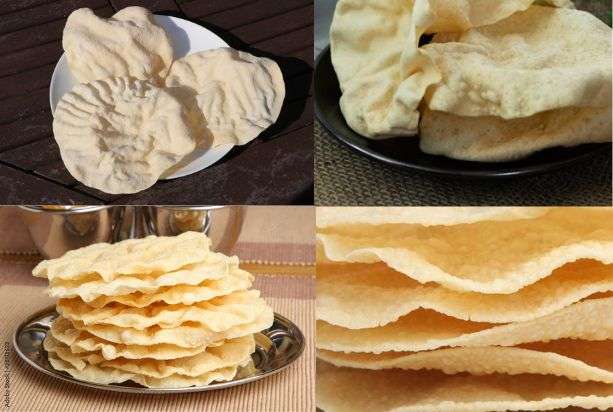Poppadoms, a staple in Indian cuisine, have been delighting the taste buds of food enthusiasts all over the world. Their crispy texture, combined with a delicate blend of spices, creates an irresistible snack or accompaniment to any meal. But for individuals with dietary restrictions, particularly those following a gluten-free regimen, a common question arises: Are poppadoms gluten free?
What are Poppadoms?
A poppadom, known in various regions as papad, papadam, or appalam, is a thin, crisp, disc-shaped food made from seasoned dough, typically originating from the Indian subcontinent. It serves as an essential element in various meals, either as a starter, a side dish, or an appetizer. Despite their lightness, poppadoms bring a burst of flavors, making them an integral part of not only Indian, but also Bangladeshi, Nepalese, and Pakistani cuisines.
Poppadoms are diverse and come in a variety of flavors. These variations depend on the types of lentils or grains used, the blend of spices, and even the cooking method. Some prefer to grill them, while others deep-fry or even roast them over an open flame. Regardless of the preparation method, the outcome is usually a satisfyingly crunchy snack that’s often served with an array of dips and pickles.
In terms of nutrition, poppadoms are typically low in calories, high in fiber, and offer a modest amount of protein. They are usually vegan-friendly, which makes them a popular choice among various diet types. However, the primary question remains, are they gluten-free? To understand this, we need to look at how poppadoms are made.
How are Poppadoms made?
Poppadoms are crafted from dough made of lentil, chickpea, black gram, rice, or potato flour. The dough is then seasoned with a mixture of Indian spices, typically including pepper, chili, cumin, or garlic, to add that extra punch of flavor. The preparation process involves rolling the dough into thin rounds and then drying them under the sun. Once dried, they are ready to be cooked and enjoyed.
Despite the seemingly straightforward process, making poppadoms is considered an art in some parts of India. The dough needs to be kneaded to the right consistency, and the rounds should be rolled out evenly to ensure uniform cooking. Even the drying process, which relies on the sun, requires a certain level of skill to achieve the perfect texture and crispness.
In recent times, with the advent of food technology, the manufacturing process of poppadoms has been automated in some places. Commercial poppadoms are often machine-made, ensuring consistency in size and thickness, and dried in specially designed ovens to save time. Despite this modern intervention, many households and local vendors still prefer the traditional method of making poppadoms.
Poppadoms Commonly Used Ingredients List:
- Lentil or Chickpea Flour – These are the primary ingredients for most poppadoms. They provide the necessary protein and give the poppadoms their characteristic taste and texture.
- Spices – A variety of spices, such as cumin, chili, and black pepper, are used for flavoring. Each spice adds a unique taste, giving poppadoms their distinctive flavor profile.
- Salt – Essential for bringing out the flavors of the other ingredients.
- Cooking Oil – Used for frying or grilling the poppadoms.
- Water – Necessary for creating the dough.
Are Poppadoms Gluten Free?
The answer is Yes. Traditionally made poppadoms are indeed gluten-free! They are made from lentil, chickpea, or other gluten-free grains, making them a suitable snack for individuals adhering to a gluten-free diet. However, one must be cautious, as not all poppadoms found in stores or restaurants are gluten-free.
Can Celiac Have Poppadoms? Is It Celiac Safe?
While poppadoms are traditionally gluten-free, people with celiac disease or non-celiac gluten sensitivity should always double-check before consuming commercially made poppadoms. Some manufacturers might add wheat flour or other gluten-containing ingredients to their poppadoms to improve texture or reduce costs.
For those strictly avoiding gluten, reading the ingredients list carefully or consulting with restaurant staff before consuming poppadoms is essential. Keep an eye out for terms like “wheat flour,” “barley,” “rye,” or “malt”—these ingredients indicate the presence of gluten. If you’re still unsure, look for poppadoms that are certified gluten-free.
Moreover, there is the issue of cross-contamination. Even if a poppadom is made with gluten-free ingredients, it could come in contact with gluten during manufacturing or cooking. For instance, if poppadoms are fried in the same oil as gluten-containing foods, there is a risk of cross-contamination. Hence, people with celiac disease or severe gluten intolerance should be extra cautious.
Final Thoughts
Poppadoms are a delightful addition to any meal, bringing a crunchy texture and a blend of flavors that brighten up the dining experience. The good news for gluten-avoiders is that traditional poppadoms are indeed gluten-free, as they are made from lentil or chickpea flour, along with a medley of gluten-free spices.
However, vigilance is key, especially when dealing with commercially made poppadoms. Always read labels, look for gluten-free certifications, and be aware of potential cross-contamination risks.
In conclusion, while enjoying poppadoms on a gluten-free diet is possible, one must always be cautious and knowledgeable about the ingredients and preparation methods involved. So next time you see poppadoms on a menu or in a store, you’ll know exactly what to check before indulging in this delicious snack!

